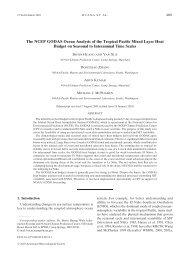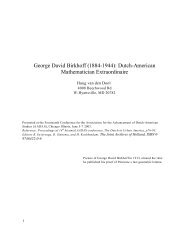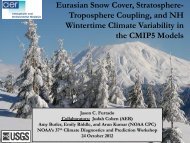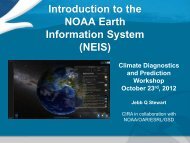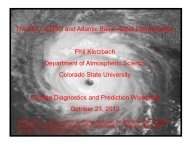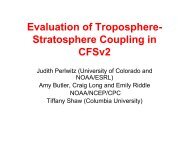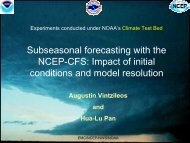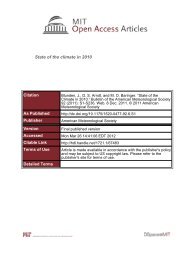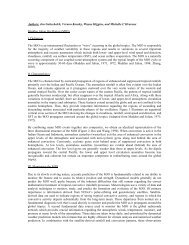Seasonality of the Pacific decadal oscillation - Climate Prediction ...
Seasonality of the Pacific decadal oscillation - Climate Prediction ...
Seasonality of the Pacific decadal oscillation - Climate Prediction ...
You also want an ePaper? Increase the reach of your titles
YUMPU automatically turns print PDFs into web optimized ePapers that Google loves.
ealizations provides an estimate <strong>of</strong> variability in results due to sampling (as may be <strong>the</strong><br />
case for <strong>the</strong> OISST).<br />
The CFS is a fully coupled ocean–atmosphere–land model, and was implemented<br />
for operational seasonal forecast at NCEP in 2004. The present version <strong>of</strong> <strong>the</strong> CFS has a<br />
horizontal resolution <strong>of</strong> T62 and 64 vertical levels in <strong>the</strong> atmospheric component <strong>of</strong> <strong>the</strong><br />
model. This dynamical forecast system has demonstrated skillful seasonal forecasts for a<br />
number <strong>of</strong> important climate phenomena, including ENSO (Wang et al. 2005; Zhang et<br />
al. 2007), <strong>the</strong> Asian-Australian monsoon (Wang et al. 2008), and <strong>the</strong> North American<br />
monsoon (Yang et al. 2009). A detailed description <strong>of</strong> model physics and an overview <strong>of</strong><br />
CFS performance can be found in Saha et al. (2006) and Wang et al. (2010).<br />
Oceanic and atmospheric fields from <strong>the</strong> CFS are utilized to analyze <strong>the</strong>ir roles in<br />
<strong>the</strong> PDO seasonal variation. Ocean temperatures (5–300 m) resolved with 26 vertical<br />
levels in <strong>the</strong> CFS are used to characterize <strong>the</strong> vertical structure <strong>of</strong> <strong>the</strong> PDO and to derive<br />
<strong>the</strong> MLD. The latter is critical to <strong>the</strong> effectiveness <strong>of</strong> SST response to atmospheric<br />
forcing (Alexander and Penland 1996). The MLD is estimated as <strong>the</strong> depth at which <strong>the</strong><br />
temperature change from <strong>the</strong> ocean surface is 0.5 o C (Monterey and Levitus 1997). The<br />
atmospheric field from <strong>the</strong> CFS is inferred from <strong>the</strong> 1000-hPa wind on a 2.5 o × 2.5 o<br />
(latitude × longitude) grid. The results based on <strong>the</strong> CFS simulation are compared to<br />
ocean temperature and 1000-hPa wind at <strong>the</strong> same resolutions from <strong>the</strong> GODAS and R2,<br />
respectively, for <strong>the</strong> period from 1982 to 2010. Surface fluxes, including latent, sensible,<br />
long wave, short wave, and Ekman heat transport from <strong>the</strong> CFS simulation are also<br />
employed to illustrate <strong>the</strong>ir seasonal variations with <strong>the</strong> PDO. The contribution to change<br />
in surface heat flux due to Ekman transport is estimated using zonal and meridional<br />
5




